No products in the cart.
June 12, 2024 8:33 am
June 12, 2024 8:33 am
Odin, the chief of the Norse gods, is a figure shrouded in mystery and rich in symbolism. This article delves into the various symbols associated with Odin, each embodying a unique aspect of his persona and his role within Viking culture.
From his wise ravens and mighty spear to the mystical runes and fierce companions, these symbols offer a window into the complex world of Norse mythology. They not only reflect Odin’s power and wisdom but also illustrate the values and beliefs of the Norse people.
By exploring these symbols, we gain deeper insights into the sagas and the spiritual life of the Vikings, enhancing our appreciation of this ancient culture.
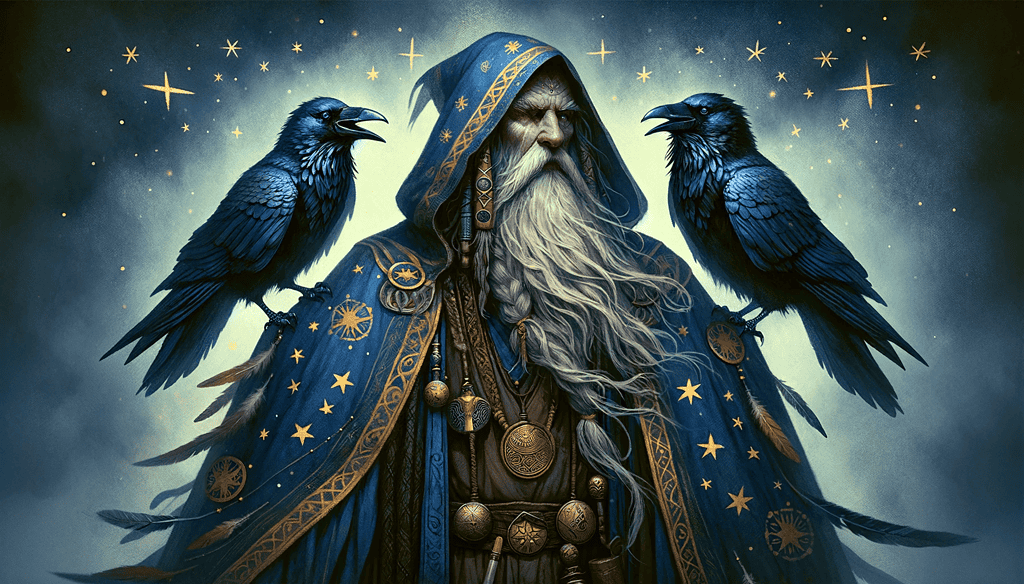
Odin, often revered as the Allfather in the Norse pantheon, holds a central place in Viking mythology. As a god of war, wisdom, poetry, and death, Odin’s influence pervades the spiritual and daily lives of the Norse people.
His multifaceted nature makes him a figure of great complexity and intrigue, embodying the Norse culture’s values of bravery, curiosity, and the pursuit of knowledge.
Odin’s role as a leader among the gods and his quest for wisdom are well-documented in ancient Norse texts. Known for sacrificing his eye in the well of Mimir to gain cosmic knowledge, Odin exemplifies the ultimate pursuit of understanding, often at great personal cost.
This act not only highlights his wisdom but also his willingness to pay the price for power, a trait admired and emulated by Viking warriors.
The stories of Odin are numerous and highlight his strategic, sometimes cunning nature. Whether he is disguising himself to walk among mortals or engaging in battles of wit with giants, Odin’s tales are pivotal in Norse literature.
These narratives not only entertain but serve as moral and cultural lessons that underline the Norse virtues of cleverness, resilience, and respect for the divine.
In Viking society, Odin was more than just a mythic figure; he was a symbol of the ideal attributes of leadership and intellectual prowess. His symbols, such as the spear Gungnir and the ring Draupnir, are omnipresent in Viking art, reflecting his significance in all areas of life from warfare to the spiritual rituals of the Norse.
By understanding Odin’s role, we can appreciate why his symbols hold profound meanings and why they were revered not just in mythology, but in everyday life as well.
These insights into Odin’s character and his impact on Norse culture set the stage for a deeper exploration of the symbols associated with him, each encapsulating elements of his vast dominion and the ancient Norse worldview.

Draupnir, a magical gold ring, holds a special place in the annals of Norse mythology. Forged by the skilled dwarf brothers Brokkr and Eitri, this artifact emerged from a heated contest with Loki, who challenged the dwarves to create treasures greater than those crafted by the Sons of Ivaldi.
Alongside Mjöllnir, Thor’s hammer, and Gullinbursti, the golden boar, Draupnir stands as a testament to the dwarves’ unparalleled craftsmanship and ingenuity in metalwork.
The ring’s name, “Draupnir,” which means “the dripper,” aptly describes its most extraordinary ability. Every ninth night, eight new rings of identical size and weight emerge from Draupnir, multiplying its form but not its magical properties.
This self-replicating feature of Draupnir is a marvel of magical engineering, showcasing the mystical depths of Norse artisan skill.
Draupnir is more than a mere trinket; it is a profound symbol of endless wealth and the eternal cycle of life and death. Its ability to replicate itself mirrors the Norse belief in the renewal of resources and the bountifulness of the earth, making it a powerful emblem of prosperity and abundance.
The ring also played a poignant role in the saga of Baldur’s death. Odin placed Draupnir on Baldur’s funeral pyre, signifying the immense prosperity Baldur had brought to the gods and underscoring the eternal link between father and son.
This act of placing Draupnir in the pyre and its later retrieval by Hermod from Hel, emphasizes the Norse values of familial bonds and the reverence for the deceased.
Draupnir’s influence extends beyond wealth, touching on aspects of love and diplomacy. In one legend, the god Freyr uses Draupnir as a token of affection, sending it to the giantess Gerd to express his love and to win her favor through his servant Skirnir.
As a symbol, Draupnir encapsulates Odin’s mastery over the realms of magic and wisdom, and the vast riches of the world. It reflects the interconnectedness of all things in the Norse cosmos, from the spiritual to the material, and emphasizes the cyclical nature of the Norse worldview, where everything is perpetually woven into the fabric of life and death.
Draupnir’s narratives enrich our understanding of Norse mythology, providing insights into the cultural and spiritual life of the Vikings.
Through its stories, we see the values that shaped the Norse world: reverence for craftsmanship, the sanctity of life cycles, and the deep connections within the community and the cosmos.
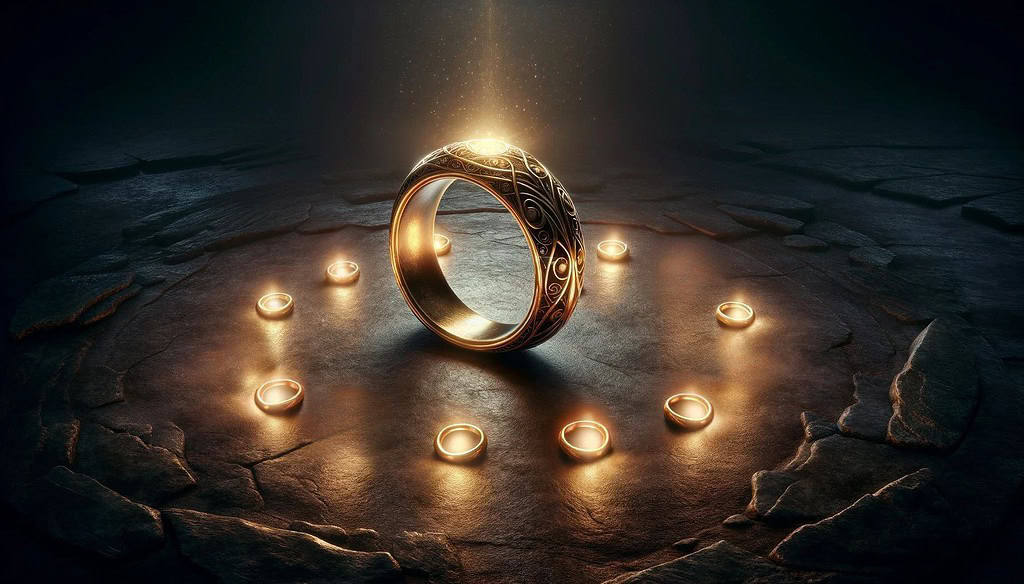
The Valknut is a mysterious and iconic symbol in Norse mythology, consisting of three interlocking triangles. Directly associated with Odin, the Allfather of the Norse gods, the Valknut appears prominently on various archaeological artifacts, which are often linked to the cult of Odin.
Its precise origin remains a topic of scholarly debate, but its connection to Norse spiritual practices and Odin’s role as the god of death and war is well-established.
The intricate geometric design of the Valknut is not merely decorative but deeply symbolic. The three interlocked triangles may represent interconnectedness between different realms of existence—such as life, death, and rebirth—or the bonds between the gods, the world, and the mortals.
This design echoes the Norse understanding of the cosmos as a complex interplay of various forces and entities.
The tricursal Valknut is characterized by three interlocking triangles formed from a single, continuous line. Commonly found on Viking runestones, this design symbolizes the interconnectivity of the Nine Worlds and the cyclical nature of life and death, reflecting Norse cosmic balance.
In contrast, the unicursal Valknut features a single, continuous loop that forms three linked triangles without reusing any segment. This rarer design symbolizes an uninterrupted spiritual journey, representing eternal protection and loyalty to Odin, guiding the soul through life’s phases.
The presence of the Valknut on burial stones and other funeral artifacts suggests its significance in Viking funeral rites. It is often interpreted as a symbol of Odin’s power to bind and unbind, a notion rooted in his ability to control the fate of souls in the afterlife.
The Valknut likely served as a protective emblem or a marker of consecration, signaling the deceased’s allegiance to Odin and ensuring their safe passage into the afterlife.
The Valknut stands as a potent symbol of transition and transformation within Norse culture. It symbolizes the warrior’s journey from life through death and potentially into Valhalla, Odin’s hall where brave souls reside.
This aspect of the Valknut highlights its role in conveying themes of bravery, loyalty, and the eternal cycle of life and death, central to Viking ethos and their understanding of existence.
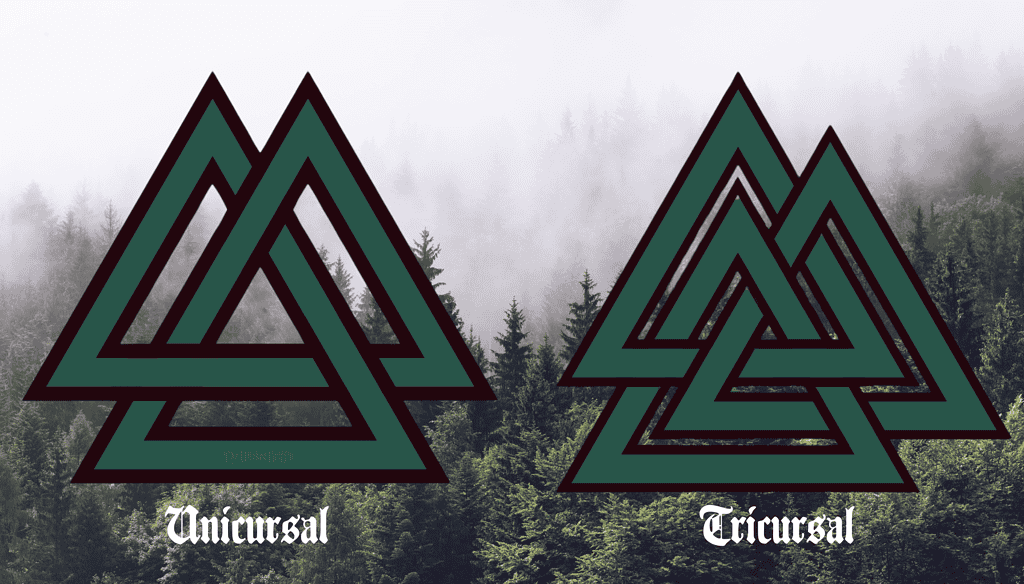
Huginn and Muninn are among the most iconic and revered creatures in Norse mythology. These two ravens are not mere birds but powerful symbols of Odin’s intellectual and spiritual prowess.
Huginn, whose name means “thought,” and Muninn, meaning “memory,” serve as Odin’s eyes and ears, flying across the worlds each day to gather information and return to whisper all they have seen and heard into Odin’s ear.
The roles of Huginn and Muninn extend beyond simple messengers; they are integral to Odin’s ability to maintain his wisdom and knowledge of the universe.
The ravens’ daily flights symbolize the continuous quest for knowledge and information, essential traits for the king of the gods and his role as the deity of wisdom and war.
Their presence also highlights Odin’s reliance on thought and memory, critical elements in Norse culture where wisdom and forethought are highly valued.
By embodying these concepts, Huginn and Muninn illustrate Odin’s comprehensive awareness and his mastery over the realm of knowledge. These ravens thus not only symbolize the mental powers of Odin but also the broader Norse appreciation for the mind’s capabilities in navigating the complexities of life and the afterlife.
Through Huginn and Muninn, we gain insight into the deeply ingrained Norse values of wisdom and vigilance.
These ravens serve as a reminder of the importance of knowledge and the need to remain aware of one’s surroundings and history, teachings that are as relevant today as they were in the times of the Vikings.

Gungnir, the spear of Odin, is not only a weapon but also a symbol of divine power and authority. Crafted by the dwarves, the most skilled smiths in Norse mythology, Gungnir was infused with spells that ensured it would never miss its target.
This spear, gifted to Odin by Loki as a part of the same series of events that produced other magical artifacts like Thor’s hammer, Mjöllnir, represents the height of magical craftsmanship and divine influence.
Gungnir is more than a mere weapon; it is a symbol of Odin’s unerring authority as the ruler of the gods.
The spear’s ability to never miss its mark reflects Odin’s role as a god of sovereignty and justice, embodying the concept that the will of the Allfather is absolute and irrevocable. This aspect reinforces his status at the top of the Aesir hierarchy and as a pivotal figure in Norse cosmology.
As a god of war, Odin’s association with Gungnir is fitting. The spear signifies not just martial prowess but also the psychological aspects of war such as strategy and foresight.
Odin’s possession of Gungnir underscores his dual role as a god of wisdom and war, highlighting the strategic dimensions of combat and the importance of mental acuity in Norse warrior culture.
Through Gungnir, we see the integration of spiritual authority and martial excellence, both central to Odin’s character. This spear encapsulates the Norse valorization of leadership qualities, not only in the physical domain but also in the realms of wisdom and governance.
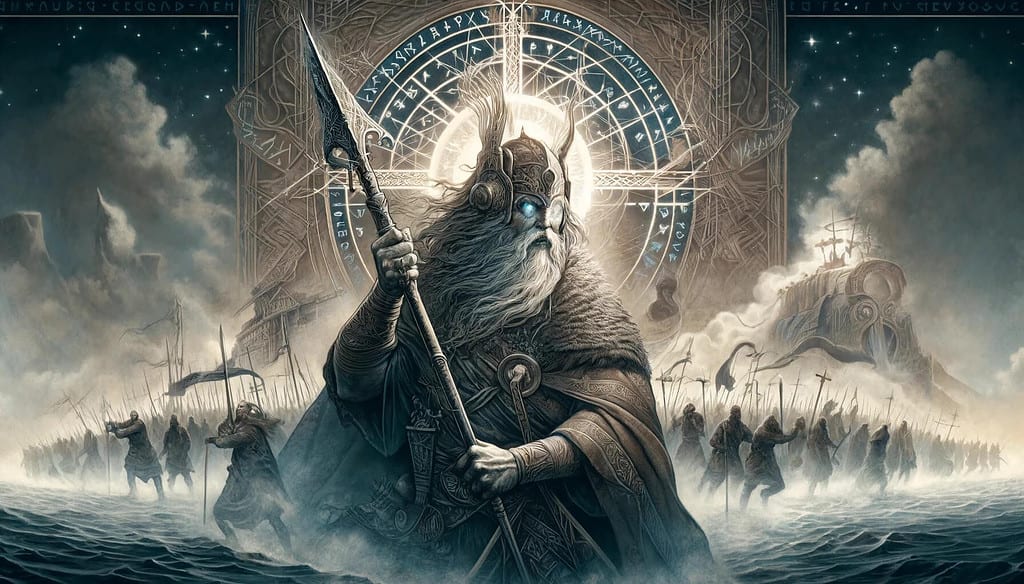
The Triple Horn of Odin is a symbol consisting of three interlocked drinking horns and is often associated with the Norse god Odin. This emblem is closely linked to the mythological tales of Odin’s quest for the mead of poetry, a magical beverage that bestows the drinker with the gift of poetic eloquence and wisdom.
The three horns represent the three draughts of the mead that Odin consumed to gain these powers.
The Triple Horn is deeply embedded in the myth of Odin’s pursuit of the mead of poetry, housed by the giant Suttungr. Odin’s strategic ingenuity during this quest highlights his aspects as the god of wisdom and poetry, not just of war and death.
The narrative underscores the importance of intellectual and spiritual nourishment, as represented by the mead, which Odin values enough to undertake significant risks.
In Norse culture, the Triple Horn symbolizes the pursuit of knowledge and the importance of creativity.
By linking the Triple Horn to the mead of poetry, Norse mythology elevates the role of the bard and the skald in society, acknowledging the power of words and wisdom in shaping the world and influencing the cosmos.
This connection between the Triple Horn and intellectual achievement reflects the broader Norse reverence for wisdom as a trait as formidable as physical strength.
The Triple Horn thus serves not only as a reminder of Odin’s adventures but also as an emblem of the profound respect for knowledge and creativity in Norse society. It reminds us that in the Norse worldview, the might of the mind is as crucial as the might of the sword.
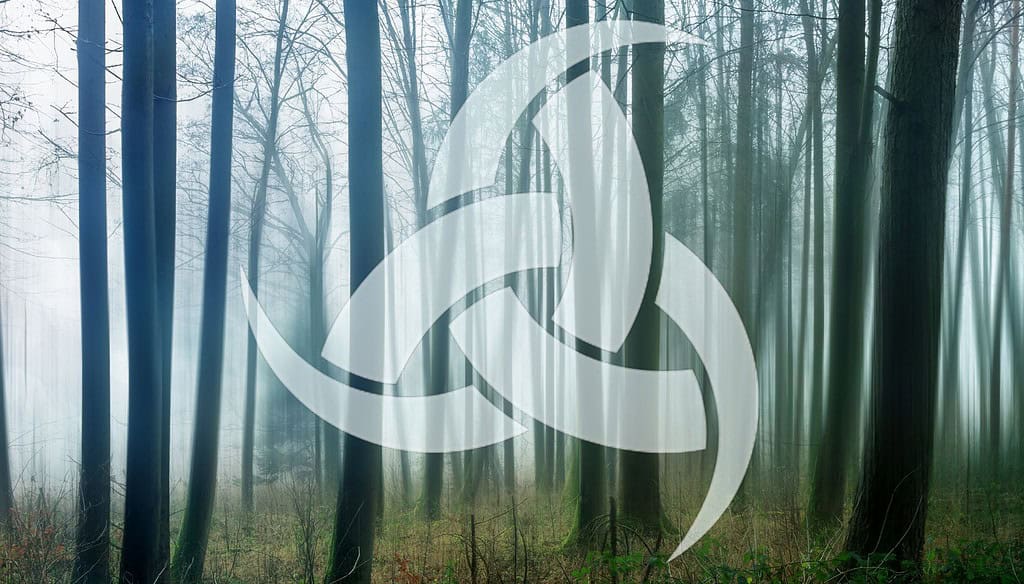
Geri and Freki, the twin wolves, serve as constant companions to Odin, the Allfather of the Norse gods. Their names translate to “the greedy one” and “the ravenous one,” respectively, and they are often depicted at Odin’s side in mythological texts.
These creatures are not just pets but integral parts of Odin’s presence, symbolizing his role as a god of war and power.
Geri and Freki are more than mere companions; they embody the virtues of strength and loyalty, which are paramount in Norse warrior culture.
Their presence alongside Odin in the halls of Valhalla and on the fields of battle illustrates the high regard in which these traits are held. The wolves’ readiness to fight by Odin’s side represents unyielding courage and the fierce loyalty expected of Norse warriors.
In addition to representing martial prowess, Geri and Freki also symbolize divine protection and guidance. Their roles in mythology highlight the protective nature of Odin, not just towards the wolves but also towards his warriors.
They reflect the reciprocal loyalty between the god and his followers, emphasizing that strength and support in battles, both literal and metaphorical, are crucial for survival and success.
The symbolism of Geri and Freki extends beyond their physical might. It encapsulates the essence of loyalty and strength as spiritual and moral supports, reinforcing the Norse belief in the importance of steadfast allies, whether in the heat of battle or the challenges of life.
These wolves remind us that in Norse mythology, loyalty and bravery are as significant as any divine power.

Sleipnir, the eight-legged horse of Odin, is a remarkable figure in Norse mythology. Born from the union of the god Loki, who transformed into a mare, and the mighty stallion Svadilfari, Sleipnir is unmatched in speed and agility.
This extraordinary steed is capable of traversing not just land but also air, embodying the boundless capabilities of his master, Odin, in his journeys across the Nine Realms.
Sleipnir’s role extends beyond mere transportation; he is a symbol of the ability to overcome boundaries and limitations. As the fastest and most agile of all horses, his eight legs enable him to move through the air and across the earth with ease, mirroring the Norse gods’ power to transcend the physical constraints of the mortal world.
Sleipnir is not only a steed but also a bridge between the realms, embodying the connection between the earthly and the divine.
The image of Odin riding Sleipnir represents the god’s mastery over the cosmos and his role as a wanderer and seeker of wisdom.
This dynamic duo symbolizes exploration and the quest for knowledge, as they move effortlessly between the worlds, gathering information and insights that are beyond the reach of ordinary beings.
Sleipnir’s ability to navigate these realms underscores Odin’s role as the god of sorcery, wisdom, and death, reflecting the interconnected nature of all things in Norse cosmology.
Sleipnir’s significance in Norse mythology is profound, serving as a reminder of the power of overcoming obstacles and the importance of connectivity in the Norse understanding of the universe.
His representation as Odin’s steed highlights the themes of journey and discovery, integral to the Norse culture’s exploration of the mystical and the unknown.
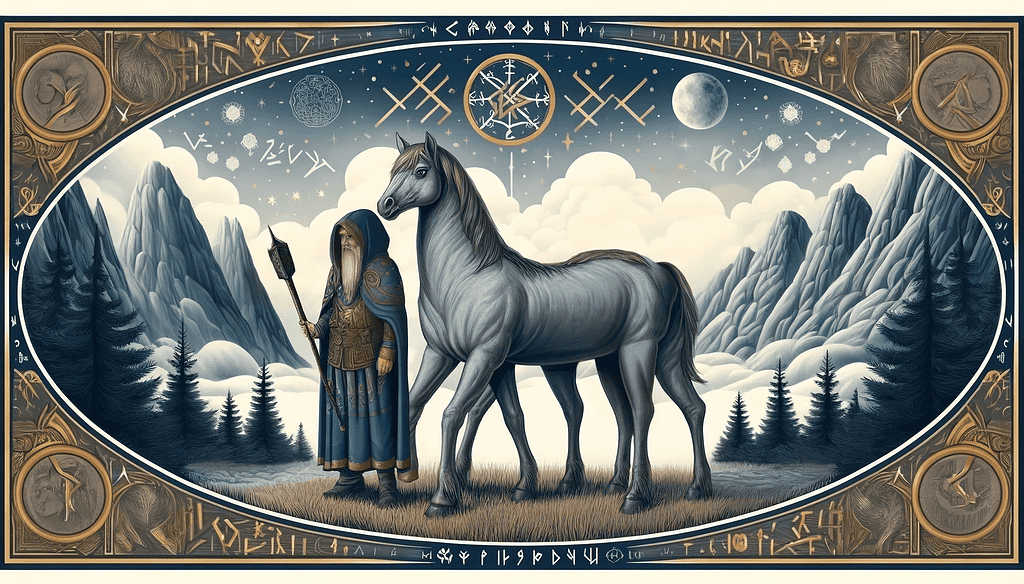
The Ansuz rune, part of the runic alphabet known as the Elder Futhark, is strongly associated with Odin, the god of wisdom and war.
Representing communication and divine inspiration, Ansuz is often linked to the god’s role as the divine communicator and harbinger of messages.
This rune encapsulates Odin’s vast wisdom, his ability to influence and his prophetic powers, making it a critical symbol within Norse spiritual practices.
Ansuz is particularly significant for its implications regarding speech and messages. In the context of Norse mythology, this rune is thought to convey not just words but divine truths, often interpreted as the ‘breath’ of Odin.
It is through Ansuz that the spiritual wisdom and decrees of the gods are believed to be transmitted to the seers and spiritual leaders within the Norse communities. This communication link underscores the sacred nature of the spoken word and its power in the Norse spiritual framework.
In runic inscriptions and divinatory practices, Ansuz is invoked for clarity in communication, both with the divine and among humans. Its presence in a reading or inscription suggests a channeling of higher wisdom or a need to focus on effective communication.
For practitioners and believers in Norse paganism, Ansuz serves as a reminder of the power of words and the importance of conveying truth with clarity and divine intent.
Through the lens of Ansuz, we see a complex interplay between the divine and the mundane, where the gods communicate their will and wisdom to humanity.
This rune helps illuminate the profound respect the Norse had for the power of speech and the transmission of knowledge, central to understanding the fabric of Norse society and its values.
The connection to Odin enhances the rune’s significance, making it a powerful symbol for those seeking to tap into the ancient wisdom and messages of the Norse gods.
Through our exploration of Odin’s symbols, we gain a profound appreciation for their roles in Norse mythology and the cultural values they embody. Each symbol, from the enigmatic Valknut to the wise ravens Huginn and Muninn, serves as a portal into understanding Odin’s multifaceted nature as a deity of wisdom, war, and governance.
These symbols do more than represent characteristics of Odin; they reflect the intricate beliefs and the worldview of the Viking age. They underscore the deep spiritual connection the Norse people had with their environment and their gods, emphasizing the significance of wisdom, power, and the cyclical nature of life.